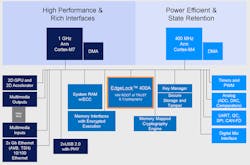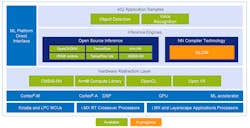NXP started its crossover microcontroller platform with the RT1050. The company’s latest i.MX RT106F and RT106L kits (Fig. 1) are based on the newer i.MX RT1060, performing facial recognition and voice control locally, respectively, using native machine-learning (ML) support that’s part of NXP’s eIQ artificial-intelligence (AI) support.
1. The i.MX RT106F (left) handles facial recognition while the i.MX RT106L (right) can support automated speech recognition without going to the cloud.
The new i.MX RT1170 (Fig. 2), based on NXP’s 28-nm FD-SIO process, contains a 1-GHz Cortex-M7 and a 400-GHz Cortex-M4. Both can handle real-time chores and ML applications. They’re supported by the EdgeLock400A hardware root-of-trust and cryptographic accelerator.
2. The i.MX RT1170 is based on a 1-GHz Cortex-M7 and a 400-MHz Cortex-M4.
The chip also incorporates a memory-mapped cryptographic engine that encrypts and decrypts internal and external memory on the fly, providing a secure environment that many application processors would envy. Even the real-time clock (RTC) is secured. In addition, there’s SRAM-based PUF (physically unclonable function) support. The crypto support handles AES-128/256, elliptic-curve cryptography, RSA-4096 encryption algorithms, and has hashing acceleration for SHA-256/512. ECC memory support is included as well.
Connectivity support includes dual Gigabit Ethernet with audio/video bridging (AVB) and time-sensitive networking (TSN). The two USB 2.0 ports have their own PHYs. Options are available for CAN-FD support.
The 2D accelerated GPU handles display chores and the video subsystem supports MIPI camera inputs. The chips can drive a 720p display at 60 frames/s and a 1080p display at 30 frames/s. There’s also a digital microphone interface along with the usual complement of timers, ADCs, DACs, and serial ports.
“As we move toward a world of a trillion connected devices, businesses are looking for real-time data insights, driving an increased requirement for on-device intelligence,” says Dipti Vachani, senior vice president and general manager of the Automotive and IoT Line of Business at Arm. “The i.MX RT1170 family efficiently combines enhanced on-device processing with low-latency performance, significantly lowering the bill-of-materials cost, while pushing the boundaries of what’s possible for embedded and IoT applications.”
NXP’s eIQ (Fig. 3) machine-learning platform supports all NXP platforms, including the RT1170. It handles most popular ML frameworks as well as ONNX. General software development is conducted by the Eclipse-based MCUXpresso IDE as well as host of third-party tools.
3. NXP’s eIQ platform supports all of its processors, including the RT1170.
Overall, the i.MX RT1170 is a power-efficient, secure edge platform that can easily deal with a range of applications, including those requiring ML support.





